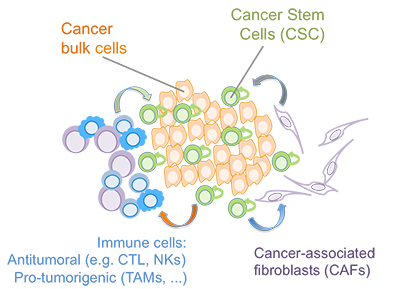Molecular Cancer & Stem Cell Research
Signaling Pathways in Cancer Stem Cells and the Tumor Microenvironment
Despite considerable progress in the fight against cancer, malignant diseases are becoming a global pandemic. More than 14 million new cases were diagnosed in 2012 and about 8 million people died of cancer worldwide. The global cancer burden is projected to reach more than 21 million new cases and 13 million deaths per year by 2030. The socioeconomic toll of cancer is also alarming; premature death and disability account for yearly economic losses of about USD 1 trillion. The development of innovative and more efficient therapies is a major challenge for biomedical research of the 21st century.
Understanding the intricate molecular and genetic networks regulating cancer growth, metastasis and drug resistance is key to the development of better therapies.
The main focus of the lab is on Hedgehog/GLI signaling and its cooperation with other oncogenic pathways in tumor-initiating cancer stem cells (CSC) responsible for tumor growth, metastasis and relapse of patients. Eradicating CSC by targeted inhibition of CSC pathways such as Hedgehog signaling is a prime focus of the lab.
Figure 1: Cancer stem cells and the tumor microenvironment. Vivid signal cross-talk between cancer cells, rare tumor initiating cancer stem cells (CSC) and the microenvironment drives cancer growth and metastasis. Understanding the molecular basis of these molecular communication processes will open up new opportunities for innovative therapies based on rational multimodal combination treatments
The Aberger group studies the molecular cues and pathways engaged in tumor-microenvironment interactions and malignant disease progression to device innovative therapies for rational-based combination treatments targeting synergistic pathway interactions. The lab applies a wide spectrum of state-of-the-art technologies ranging from –omics approaches to predictive in vivo cancer models and assays involving primary patient material. The Aberger lab has identified synergistic interactions of the Hedgehog and EGFR or PDGFR pathways, accounting for malignant progression of skin and pancreatic cancer. This knowledge has opened new avenues to the development of innovative rationale-based combination treatments with improved therapeutic efficacy.
To advance cancer research and therapy in the Salzburg area, the Aberger group together with the Salzburg Cancer Research Institute at the University Clinics Salzburg (SALK/PMU) founded the “ Cancer Cluster Salzburg“ (CCS). CCS constitutes a research network of 16 expert groups in basic, translational and clinical cancer research to explore new cancer-driving mechanisms and develop innovative treatments with improved therapeutic efficacy (for details see: www.cancercluster-salzburg.at).
Selected Publications
- Pencik J, Schlederer M, Gruber W, Unger C, Walker SM, Chalaris A, Marié IJ, Hassler MR, Javaheri T, Aksoy O, Blayney JK, Prutsch N, Skucha A, Herac M, Krämer OH, Mazal P, Grebien F, Egger G, Poli V, Mikulits W, Eferl R, Esterbauer H, Kennedy R, Fend F, Scharpf M, Braun M, Perner S, Levy DE, Malcolm T, Turner SD, Haitel A, Susani M, Moazzami A, Rose-John S, Aberger F, Merkel O, Moriggl R, Culig Z, Dolznig H, Kenner L. STAT3 regulated ARF expression suppresses prostate cancer metastasis. Nat Commun. 2015 Jul 22;6:7736. doi: 10.1038/ncomms8736. IF 10.7
- Kern D, Regl G, Hofbauer SW, Altenhofer P, Achatz G, Dlugosz AA, Schnidar H, Greil R, Hartmann TN, Aberger F. Hedgehog/GLI and PI3K signaling in the initiation and maintenance of chronic lymphocytic leukemia. Oncogene 2015;doi: 10.1038/onc.2014.450. [Epub ahead of print]. IF: 8.6
- Aberger F, Ruiz IAA. Context-dependent signal integration by the GLI code: The oncogenic load, pathways, modifiers and implications for cancer therapy. Semin Cell Dev Biol 2014;33C:93-104. IF: 6.4
- Wolff F, Loipetzberger A, Gruber W, Esterbauer H, Aberger F*, Frischauf AM. Imiquimod directly inhibits Hedgehog signalling by stimulating adenosine receptor/protein kinase A-mediated GLI phosphorylation. Oncogene. 2013 Dec 12;32(50):5574-81. doi: 10.1038/onc.2013.343. Epub 2013 Sep 2. *corresponding author; IF: 8.5
- Teperino R, Amann S, Bayer M, McGee SL, Loipetzberger A, Connor T, et al. Hedgehog partial agonism drives Warburg-like metabolism in muscle and brown fat. Cell 2012;151:414-26. IF: 33.2
- Eberl M, Klingler S, Mangelberger D, Loipetzberger A, Damhofer H, Zoidl K, et al. Hedgehog-EGFR cooperation response genes determine the oncogenic phenotype of basal cell carcinoma and tumour-initiating pancreatic cancer cells. EMBO Mol Med 2012;4:218-33. IF: 10.3
- Pospisilik JA, Schramek D, Schnidar H, Cronin SJ, Nehme NT, Zhang X, et al. Drosophila genome-wide obesity screen reveals hedgehog as a determinant of brown versus white adipose cell fate. Cell 2010;140:148-60. IF: 33.2
- Schnidar H, Eberl M, Klingler S, Mangelberger D, Kasper M, Hauser-Kronberger C, et al. Epidermal growth factor receptor signaling synergizes with Hedgehog/GLI in oncogenic transformation via activation of the MEK/ERK/JUN pathway. Cancer Res 2009;69:1284-92. IF: 9.5
The researchgroup is a member of the international “PhD Program ICA” from the FWF and a member of the ” Allergy-Cancer-BioNano Research Centre “ from the University of Salzburg.





